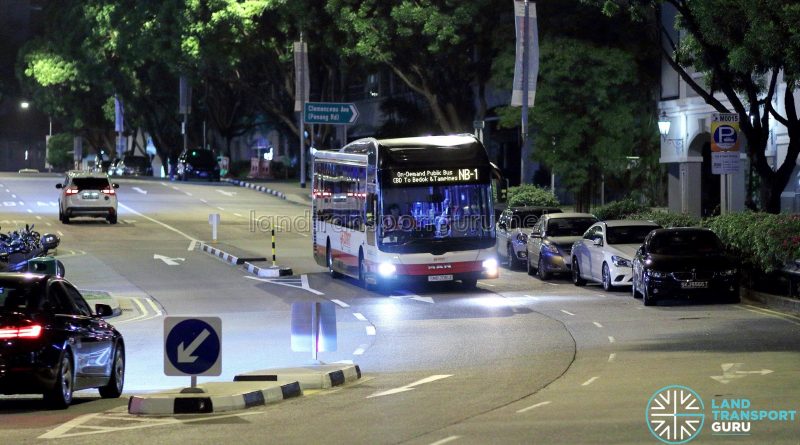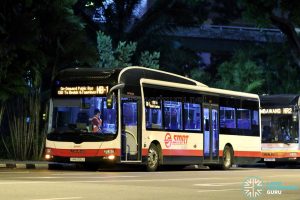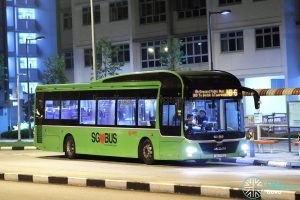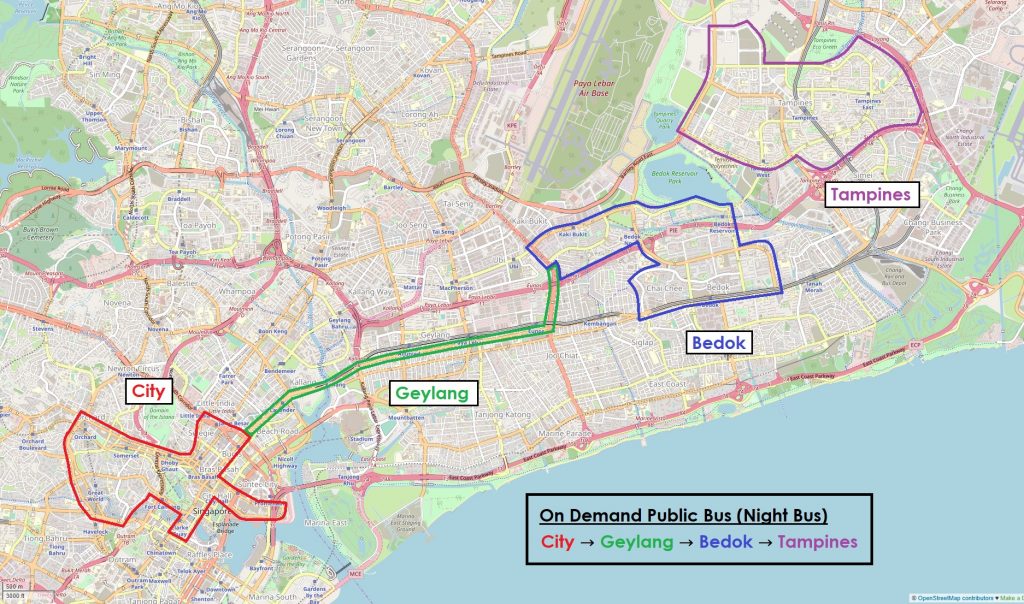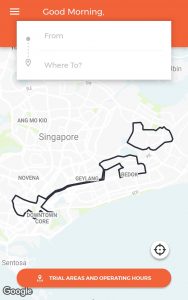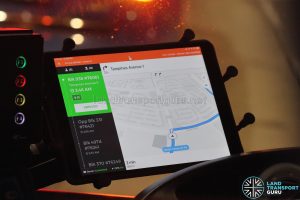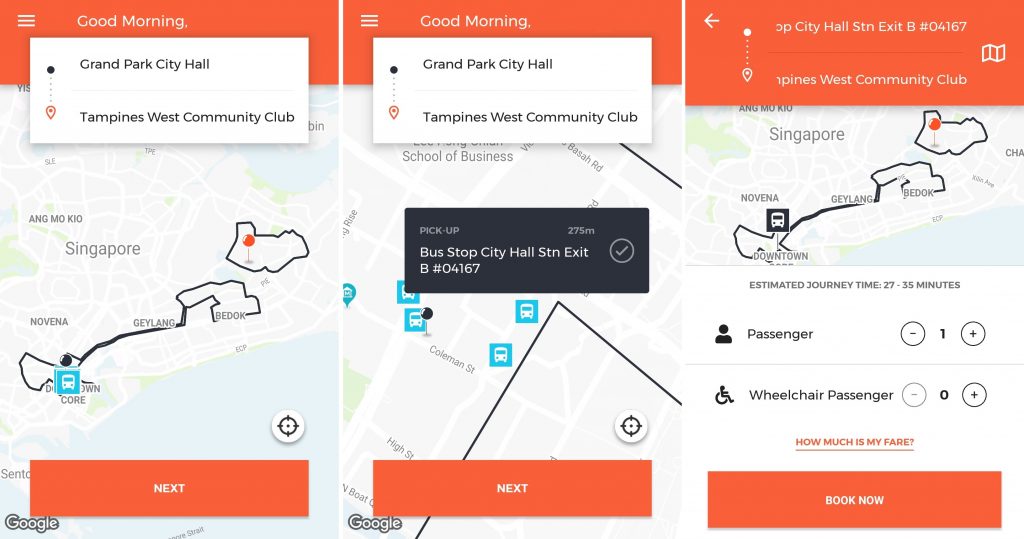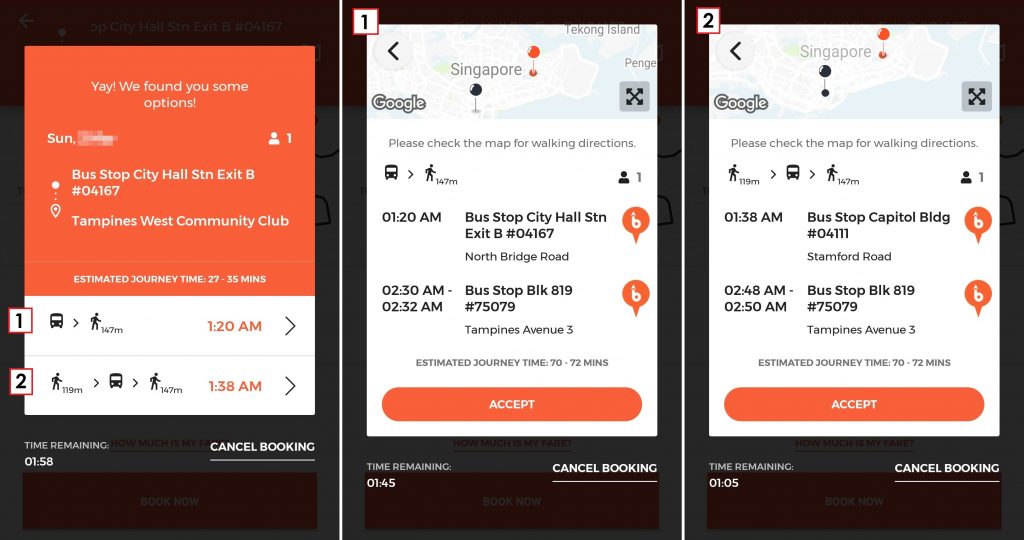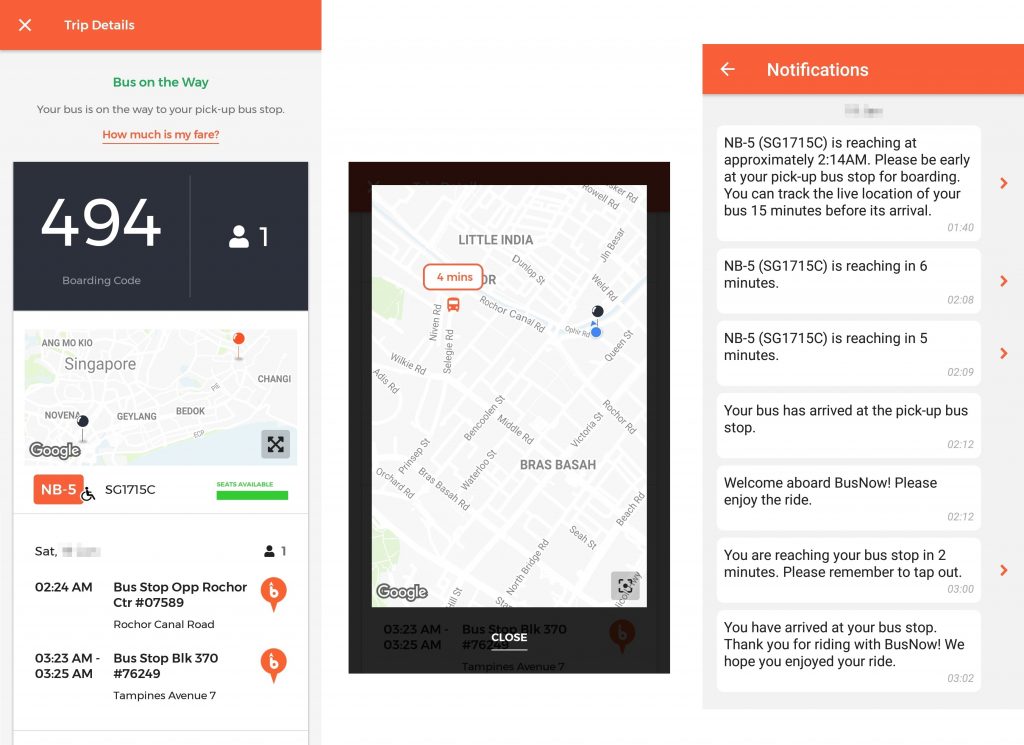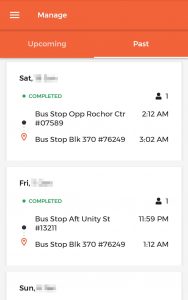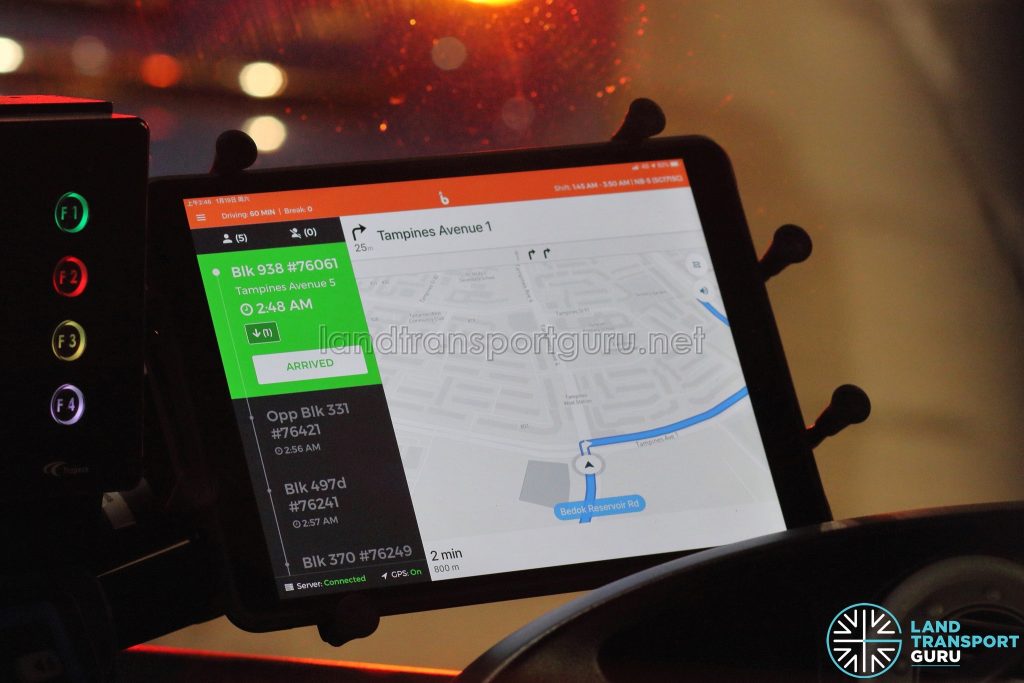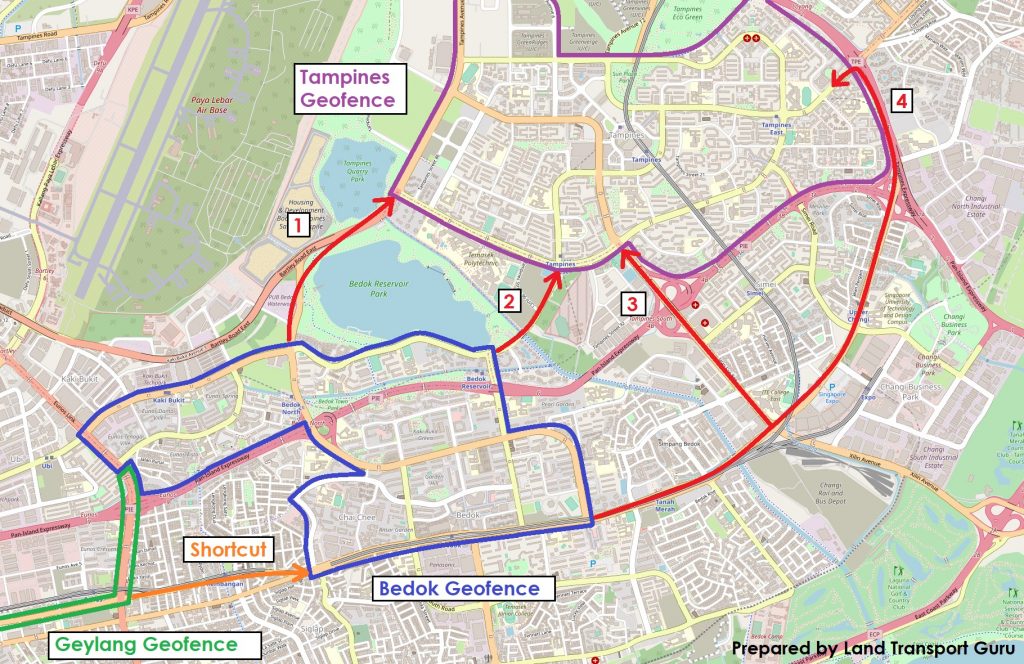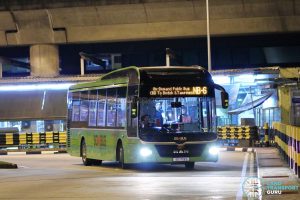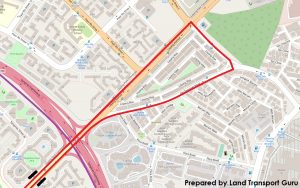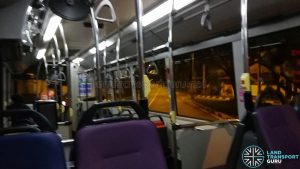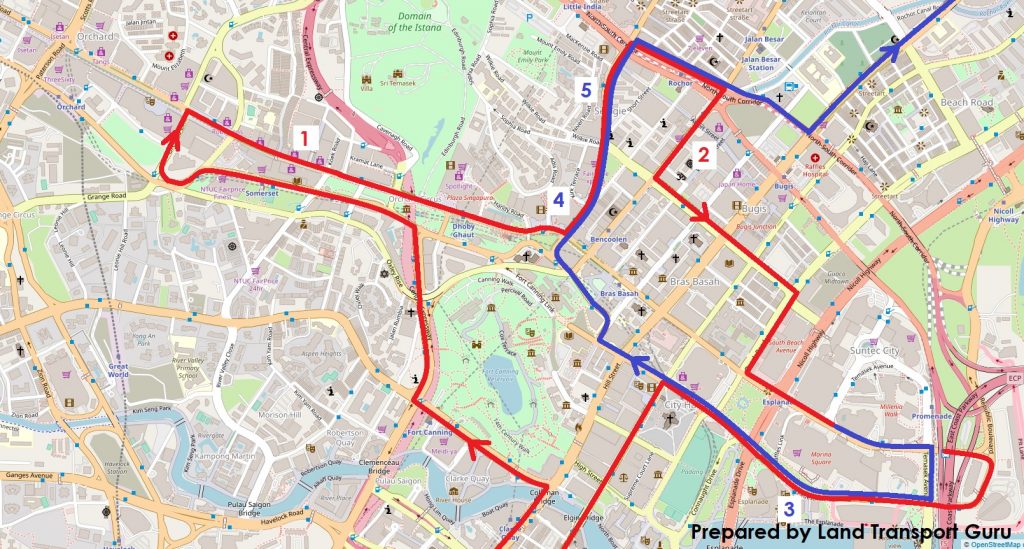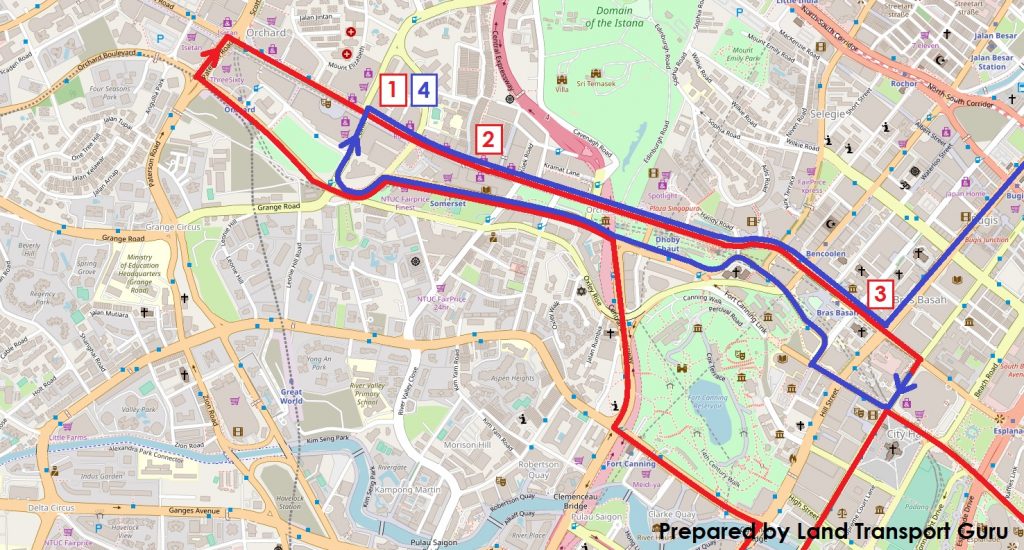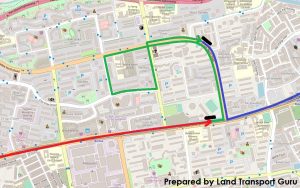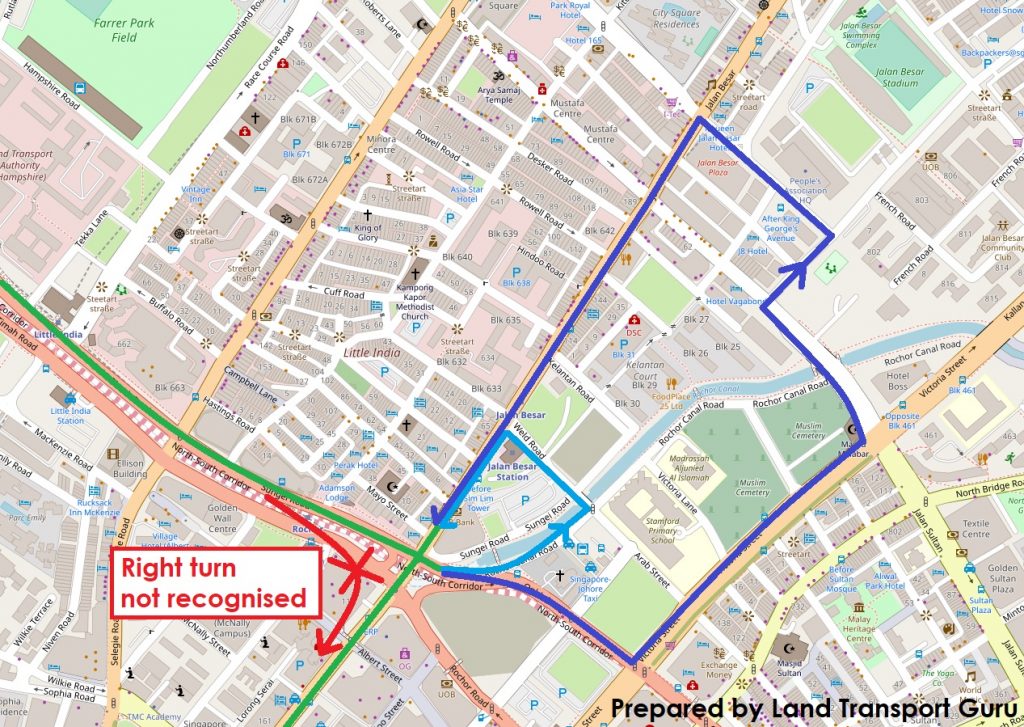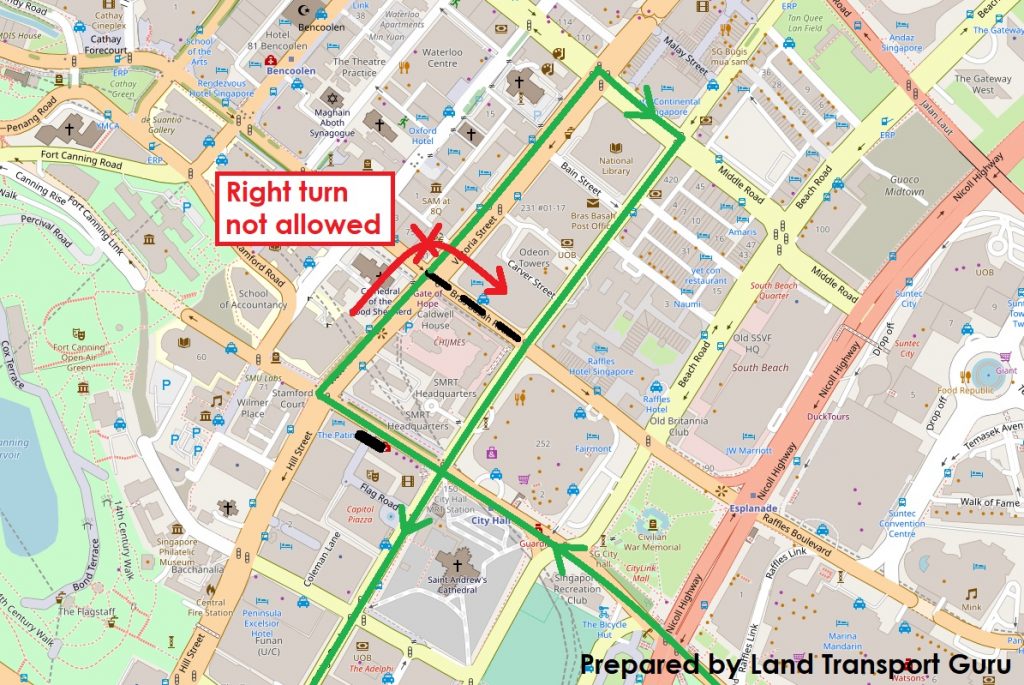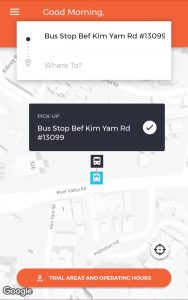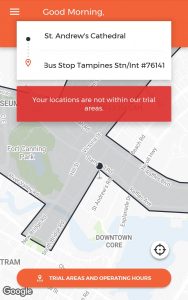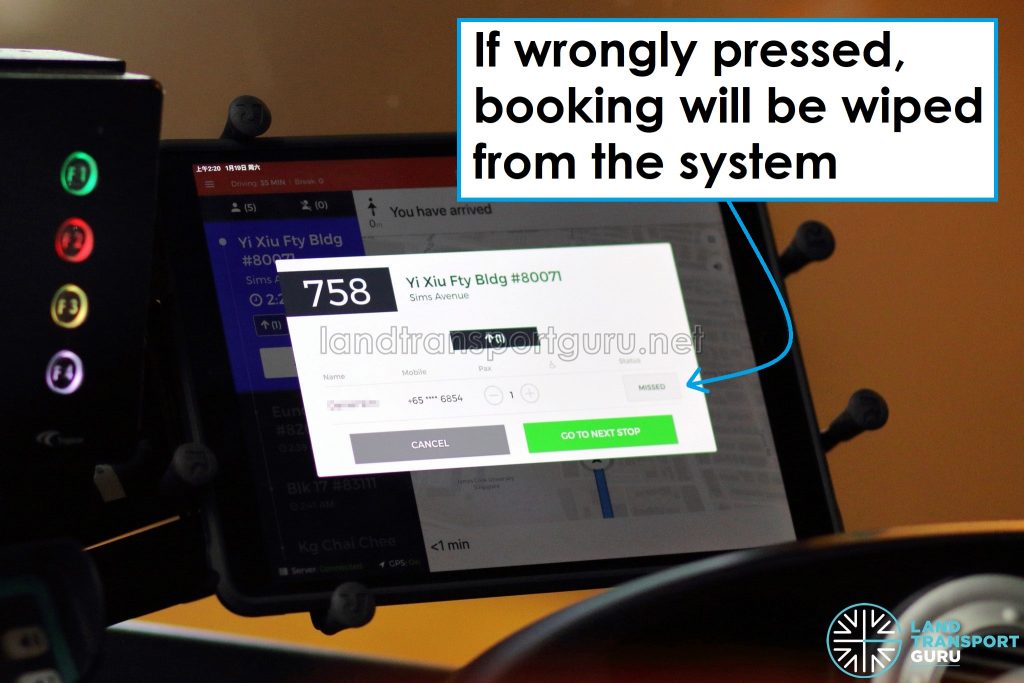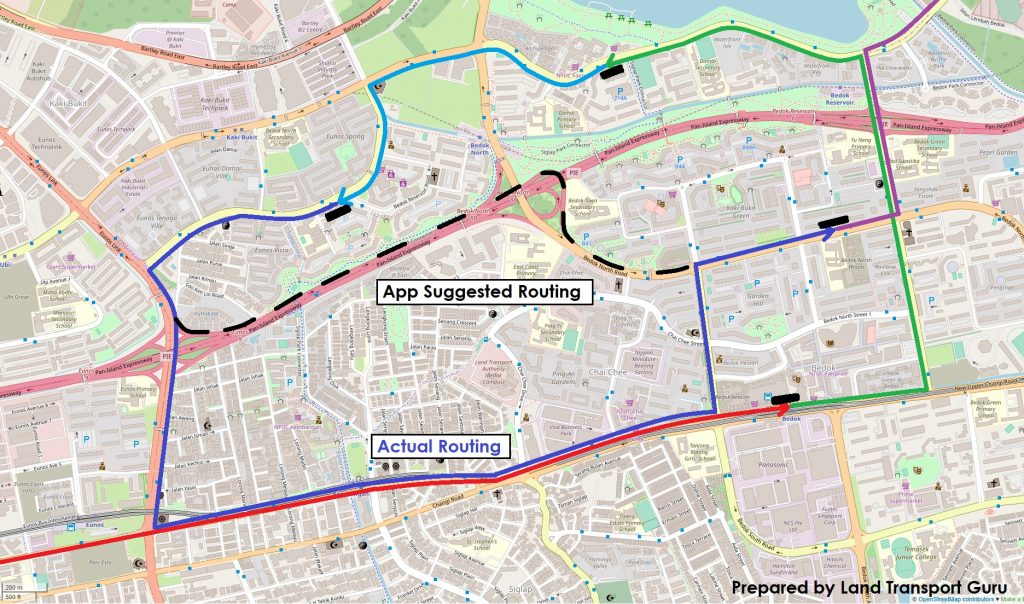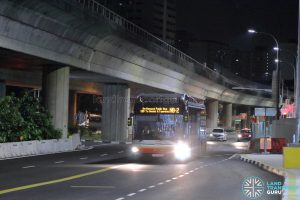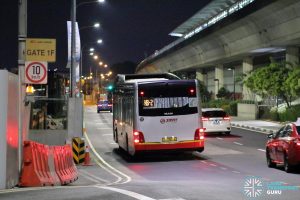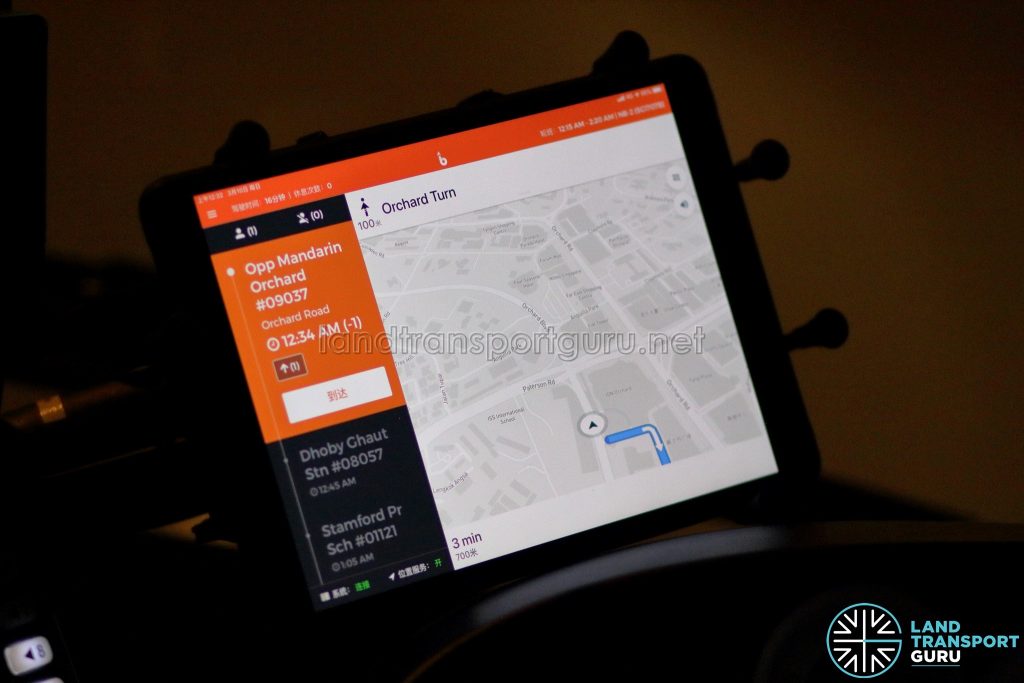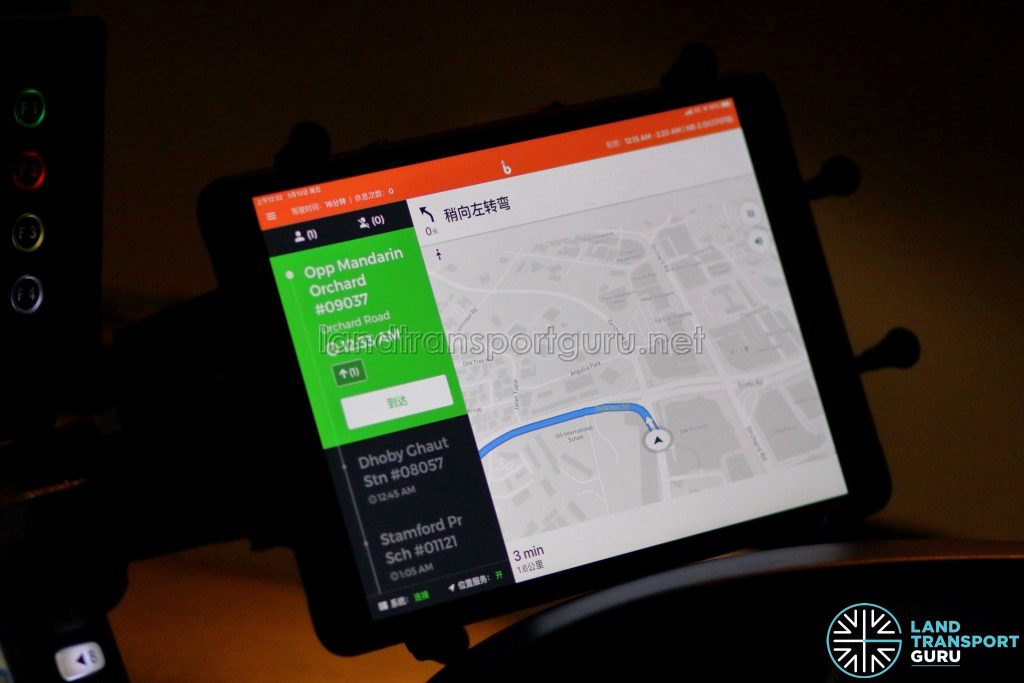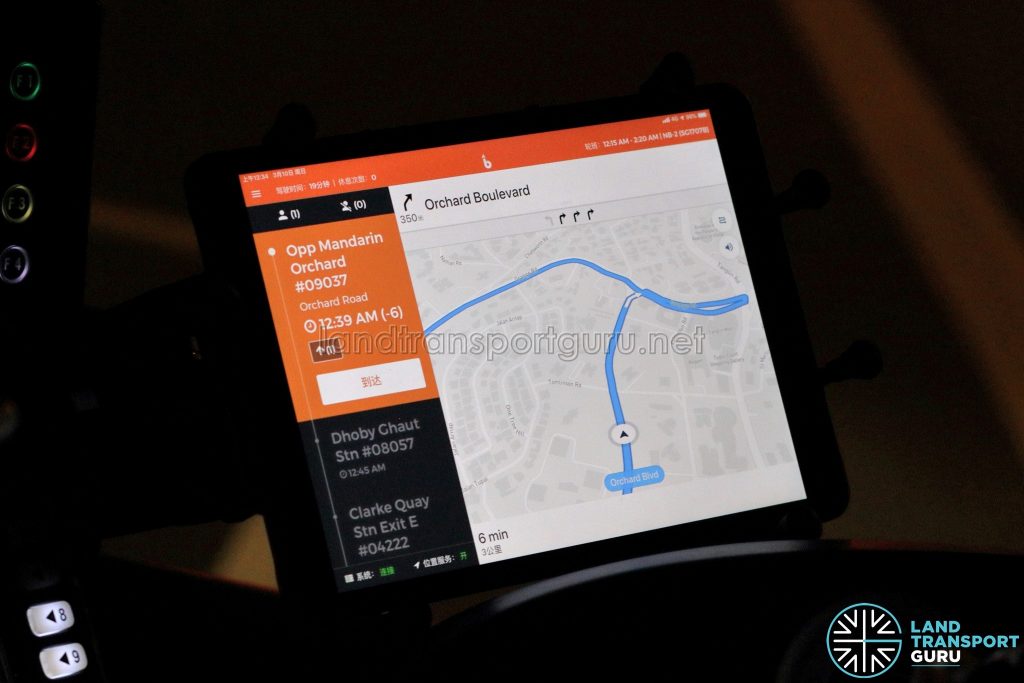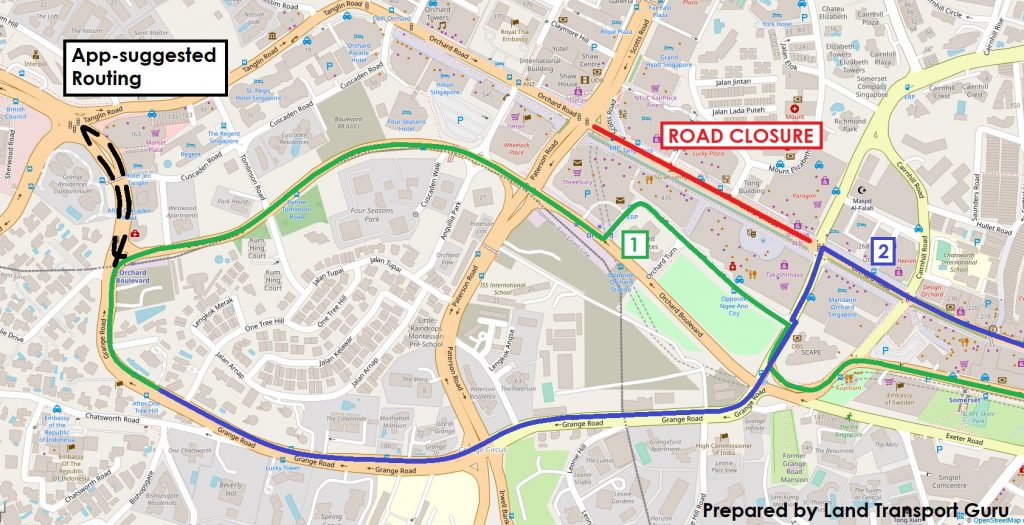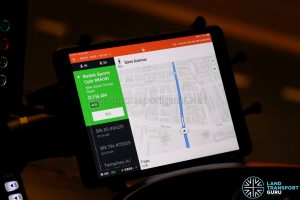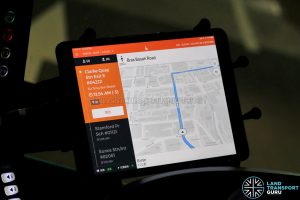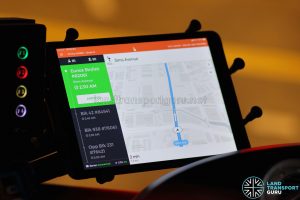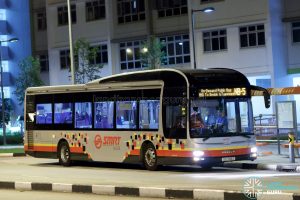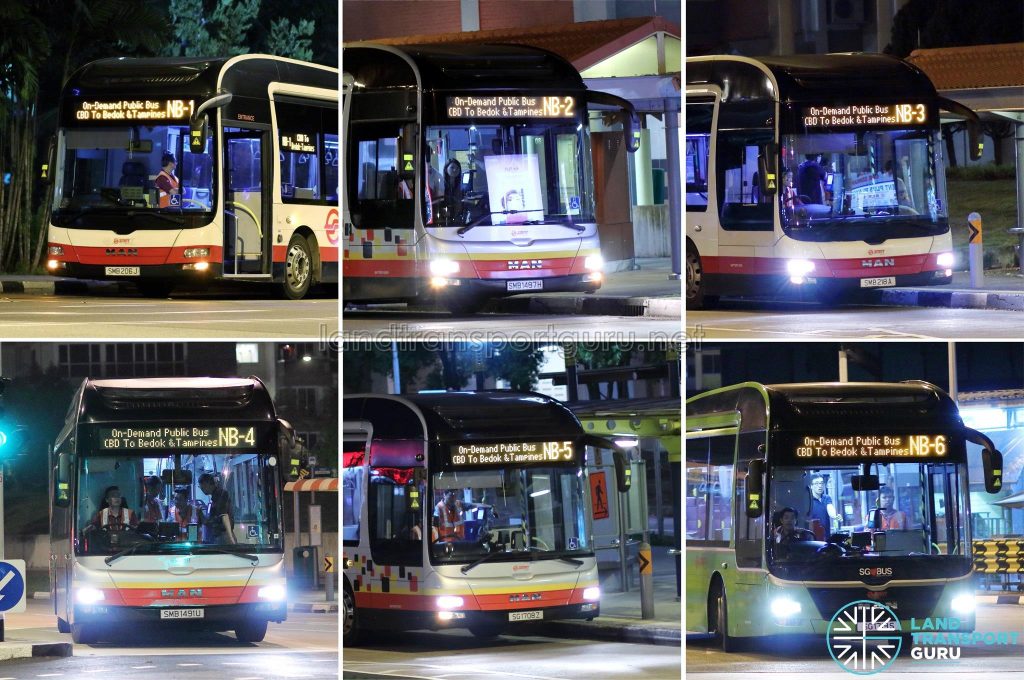The On-Demand Night Bus trial was offered from 4 January 2019 and 15 June 2019, during the late night hours on Fridays, Saturdays and Eves of Public Holidays. To use the service, passengers must download and book a ride through the BusNow mobile app.
The trial route, operating from the CBD to Geylang, Bedok and Tampines, replaced NightRider NR7 service which was suspended for the duration of this trial.
Overview
Why On-Demand Night Bus?
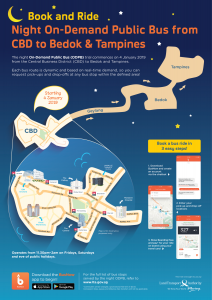
The On-Demand Public Bus (ODPB) trial is an initiative by LTA to evaluate the feasibility of operating public bus services with routes and schedules based on real-time commuter demand, instead of following fixed routes and pre-determined timetables.
Using a mobile application, commuters will be able to book an ODPB ride by requesting to be picked up and dropped off at any bus stop within defined areas from the Central Business District (CBD) to Bedok and Tampines via the Geylang corridor during the designated operating hours.
For the On-Demand Night Bus trial, commuters are offered flexible inter-town and intra-town commuting options during the late night hours, with the added benefit of serving all bus stops within a geofenced area (with minor exceptions) for increased catchment area over a traditional fixed-route night bus. In total, 343 bus stops are covered under the Night Bus trial.
Pending the outcome of this trial, the LTA may expand the Night Bus to other parts of Singapore. These measures would also consolidate the current fixed-route night bus network, maximizing their catchment area and reduce duplicating routes in the long run.
Operating Hours
The service operated from 11:30 pm to 2:00 am on Fridays, Saturdays and Eves of Public Holidays, with buses departing Marina Centre Terminal at roughly 30-minute intervals. 6 buses were deployed on these six trips during operating days.
Although the official operating hours state that the service only operates up to 2:00 am, it is still possible to book the last bus beyond 2:00 am if the bus is still within the zone, or yet to reach the zone. For example, it is possible to book an On-Demand trip from Bedok to Tampines at 2:30 am or later.
Buses operate with the service number NB-x, where x is a single-digit number between 1 and 6. Since the numbers are dispatched in order, the first bus (11:30 pm) will be numbered NB-1, the second bus (12:00 am) numbered NB-2, and so on.
Coverage Area & Booking rules
The unidirectional ODPB (Night Bus) operates from the City to Geylang, Bedok and Tampines in that order. With minor exceptions, passengers can board and alight at any bus stop within the geofenced areas.
- As the bus travels from CBD to Geylang, Bedok and then to Tampines, commuters cannot book rides in the other direction (i.e. Tampines to Bedok, or Geylang to CBD)
- Intra-town trips (i.e. boarding and alighting within the CBD, Bedok or Tampines estate) are allowed
A detailed list of bus stops served within each catchment area can be found on the On-Demand Public Bus (Night Bus – CBD to Bedok / Tampines) article.
Infrastructure
A contract for the development of software and hardware solutions for the ODPB (Night Bus) system was awarded to Ministry of Movement Pte. Ltd (SWAT), who also developed the ODPB platform for the ODPB (Marina Bay / Downtown). Via Transportation, Inc. (Via) secured the contract for the ODPB (Joo Koon).
Under the tender, SWAT:
- Developed the dynamic matching and routing algorithm to enable buses to be deployed according to real-time commuter demand
- Conducted simulations to determine operational trial parameters
- Developed develop both software and hardware solutions for the ODPB system:
- Mobile apps for commuters
- Tablet apps for bus captains
- Back-end tools for service monitoring services during the trial
- Train Bus Captains and support staff to operate the system
- Provide operational and maintenance support
Mobile Application
For commuters, the BusNow App is available on the Google Play Store and Apple App Store. It allows commuters to make bookings on their smartphone.
The process of booking a ride is as follows:
- Specifying start and endpoint
Commuters may use an address, or street/building names - Confirming pick-up and drop-off bus stop
The application will suggest a pick-up and drop-off bus stop near the selected start and endpoint - Number of passengers
Commuters must select the number of passengers as part of the booking, and whether there are passengers-in-wheelchair
- Suggested route
The application will return a selection of travel options for commuters to choose from, as well as their estimated pick-up times and journey duration
- Confirm booking
When the booking is confirmed, passengers receive a confirmed pick-up time and will be able to check the location of the bus updated in real time. Automatically-generated notifications will be sent as the bus approaches the boarding stop. A booking code will be generated when the bus has arrived at the bus stop. - Boarding the bus
The Bus Captain checks the boarding code against the one on the commuter’s smartphone to ensure that the right person has boarded the bus. Alternatively, if the boarding code fails to generate, the Bus Captain can verify the last four digits of the commuter’s handphone number, which is displayed on the driver’s display tablet. Automatically-generated notifications will be sent as the bus approaches the alighting stop.
- After the journey
Commuters will be able to rate their journey out of 5 stars, and a record of the booking is stored in the app.
Buses
SMRT Buses operates the ODPB (Night Bus) service, with MAN A22 single-deck buses based at Woodlands Bus Depot.
Each bus is fitted with a tablet which runs on the BusNow Driver Application, instructing Bus Captains on the route to follow, and en-route stops to call at. The tablet mount is removable, and outside of ODPB (Night Bus) operating hours, the buses run without the tablet attached.
On the left column, a list of bus stops or waypoints is listed, along with their estimated time of arrival. On the right side, a map is shown with the bus route highlighted in blue. The tablet also issues audio navigational alerts to the Bus Captain, which can be configured in English or Mandarin Chinese.
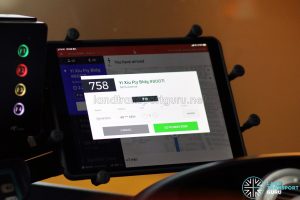
The application also generates a three-digit boarding code which the Bus Captain uses to verify a passenger’s booking when he/she boards the bus. At boarding, the passenger’s name and last 4 digits of their handphone number will also be displayed.
Back-end tools
Back-end tools developed by SWAT are used in SMRT’s BOCC Operation Control Centre (BOCC) to monitor the ODPB (Night Bus) trial during operating hours.
Observations
A. Operational pattern
The six trips of the ODPB Night Bus depart Maina Centre Terminal at 30-minute intervals. Shortly before the bus is due to depart, a booking window opens where passengers must make a booking quickly while the routing of the bus is being generated through incoming bookings. Passengers who are making bookings far off the “plotted” route, such as from Zion Road, maybe be forced to wait for the subsequent bus if they do not make their bookings in time.
The bus usually plots its route in a similar fashion to the old operating pattern of NR7, first serving City Hall and Clarke Quay, followed by River Valley Road, Orchard, Dhoby Ghaut, and Bugis before heading towards Tampines. Some parts of the City may be skipped if there are no boarding passengers.
From Bugis to Eunos MRT, the bus will be forced to ply Victoria Street, Kallang Road, and Sims Avenue, even if there are no boarding passengers. From Eunos, the bus will either turn left towards Kaki Bukit/Bedok Reservoir or proceed straight on to Bedok/Chai Chee if there are no boarding/alighting passengers at Bedok Reservoir.
Between Bedok and Tampines, the bus has been observed to ply either Bedok Reservoir Road, Upper Changi Road East/TPE, Upper Changi Road East/Simei Ave, or, in some instances, Bedok North Road/Tampines Avenue 10 if there are no boarding/alighting passengers at Bedok.
In addition, Tampines Bus Interchange is used as the terminating point for all ODPB (Night Bus) trips. Bus Captains must pass through it as a waypoint before ending service.
B. Dummy Bookings
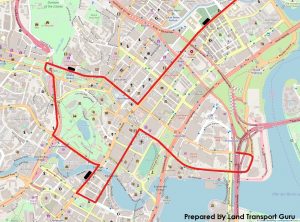
It has been observed that ‘dummy bookings’ are made for all trips at selected bus stops along the route, which are as follows:
- (04222) Clarke Quay Stn Exit E, Eu Tong Sen St
- (08057) Dhoby Ghaut Stn, Orchard Rd
- (01121) Stamford Pr Sch, Victoria St
- (82061) Eunos Stn/Int, Sims Ave
These ‘dummy bookings’ must be acknowledged by the Bus Captain when the bus reaches the bus stop, but no passenger booking is reflected within the system. This is likely a workaround to ‘force’ the bus to follow a certain route, and to prevent the bus from immediately proceeding out of the City area from Marina Centre Terminal if there are no bookings.
C. Default operating route (when no passengers)
Even if no passengers place bookings for the ODPB (Night Bus), the bus will continue its trip from the City to Tampines via Geylang and Bedok. Passengers upstream can continue to make bookings while the bus is on its way. The bus will call at mandatory stops to serve ‘dummy bookings’ as mentioned above, and after reaching Eunos, would then proceed via Bedok and straight to Tampines Bus Interchange, which is used as the terminating point for all ODPB (Night Bus) trips.
D. Exiting the Geofence
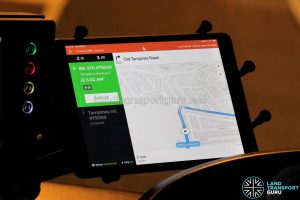
While the geofence defines the bus stops where bookings can be selected, the routing of buses is not restricted to this geofence and buses often exit the geofence (even within an estate) while plotting a route between bus stops. Some examples are:
- Clemenceau Ave between River Valley Rd and Havelock Rd, skipping Mohd Sultan Rd
- Loyang Avenue, New Loyang Link and Old Tampines Rd when looping at Tampines Avenue 7
- Bukit Timah Road & Scotts Road (from Bugis to Orchard due to intra-CBD booking)
- Sims Ave East (from Eunos to Bedok, if no bookings made at Bedok Reservoir)
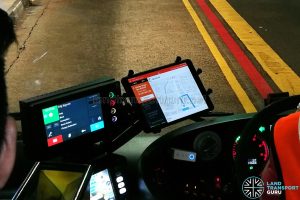
E. Missing a Checkpoint
When an en-route checkpoint is missed, the routing application would not continue to next stop unless that checkpoint is acknowledged. The application will display navigation instructions back to the last unacknowledged checkpoint if a checkpoint is skipped.
As seen in the scenario on the right, an ODPB (Night Bus) at Victoria St is given driving directions back to the previous waypoint — Orchard Road (Dhoby Ghaut Stn) — after the Bus Captain failed to acknowledge the previous waypoint.
Operational Issues
The rollout of the ODPB (Night Bus) was not without issues. Here are several operational hiccups observed as well as contributed by riders on the ODPB (Night Bus):
1. Service unavailable outside of booking window (first day)
At the start of the ODPB (Night Bus) trial, it was difficult to get a booking from the CBD as the booking window for each trip did not open until shortly before a bus was due to depart from Marina Centre Terminal. Most of the time, the app reflected that the service was “unavailable” even though buses were plying their routes within the CBD area. This issue has largely been resolved after the first week of operations.
2. Long-winded routing
While not a technical fault, the nature of having one bus serving point-to-point connections meant that buses would be forced to long-winded routings to accommodate commuters’ travel patterns. In some cases, intra-CBD bookings force buses on long routings that add significantly more waiting time (for boarding passengers) or journey time (for onboard passengers) heading towards the heartlands. This occasionally leads to some commuters cancelling their bookings.
Some intra-CBD bookings, such as Bugis to Orchard, and City Hall to Zion Road, have been observed. In some instances, the rear bus is able to complete its route ahead of the front bus, despite being scheduled 30 minutes apart.
Some observed routings are illustrated below:
3. Distinguishing bus stop pairs
While the routing algorithm works to plot the shortest route between bus stop pairs as selected by commuters, it is unable to distinguish between bus stop pairs. This issue results in buses taking long and unnecessary detours around a block to make a u-turn when bookings are made on opposite sides of the same road.
4. System Errors
4A. Routing algorithm does not recognise right turn
When making a right turn from Sungei Road to Bencoolen Street, the app does not recognise that the junction allows for right-turning traffic. The bus is thus forced to make a round via: in one instance, via Rochor Canal Rd and Weld Rd; and in another instance, via Victoria Street, Syed Alwi Rd, King George’s Ave and Kitchener Rd.
4B. Routing algorithm recognises a non-existent right turn
When heading from Stamford Rd (Capitol Bldg) to North Bridge Rd (southbound), the application recommends turning from Stamford Rd to Victoria St, Bras Basah Rd and North Bridge Rd, unaware that the junction between Victoria St and Bras Basah Rd does not allow for right turns. Buses are forced to miss the turn and the algorithm proceeds to generate an alternative route via Middle Rd instead, which is the correct routing.
4C. Inaccurate waiting time estimate
When booking an ODPB (Night Bus) ride from the heartlands, the mobile application is known to provide an inaccurate estimated time of arrival; buses can arrive more than 10 minutes earlier than the arrival time generated by the app. It is thus safest to wait at the bus stop for the bus after one makes a booking.
4D. Not updated with new bus stops
New bus stops, such as those Tampines Avenue 6: (75471) Blk 602B, (75479) Blk 619A, (75481) Blk 609D, (75489) Opp Blk 609D; which were added after the launch of the ODPB (Night Bus), are not available for booking in the system, although these bus stops fall within the geofenced area.
Note: These bus stops were later made available for booking, as of late March 2019.
4E. Bus stop placement error
As the algorithm generates the bus route based on the location of each bus stop, it is crucial that location coordinates of every bus stop are correctly reflected in the system. When bus stops like (13099) Opp Kim Yan Rd, River Valley Rd are reflected incorrectly (in this case, on the Eastbound side of the road), the ODPB (Night Bus) will be directed to the wrong side of the road while the commuter waits at what he/she perceives to be the correct bus stop (that is, on the Westbound side of the road). This inevitably leads to the commuter missing the bus.
4F. Landmarks outside of geofence not recognised
While this is a minor issue, it is worth noting that landmarks outside the geofenced areas cannot be selected as boarding and alighting stops, even if they are right next to a bus stop within a geofence. An easy way around this issue is to simply select the bus stop instead of the landmark.
5. Bus Driver unfamiliarity
5A: Missing turns
Bus Captains occasionally miss turns and deviate from the recommended route whilst on the ODPB (Night Bus). It is our wish that commuters cut Bus Captains some slack when this happens, due to unfamiliarity with the roads among other reasons, especially since much of the ODPB (Night Bus) catchment area is not served by existing SMRT bus services.
When a turn is missed, the dynamic routing algorithm is able to generate a new route that would take the bus back to its next intended stop. As per company procedure, the Bus Captain may stop the bus and call the OCC for further instructions.
5B: Wrongly indicating missed passenger
If the Bus Captain fails to acknowledge a passenger booking by mistakenly pressing the “no-show” option on the driver’s display tablet, the passenger’s alighting stop will be erased from the bus’ dynamic routing even though the passenger has boarded the bus. This results in complications further down the route when the passenger realises that the bus has gone past his/her intended destination. In this scenario, the Bus Captain will likely call OCC for further instructions.
It is noted that the user interface of the driver tablet places the no-show button (“Missed”) very close to the accept button (“Go to next stop”) which adds to the risk of accidental presses.
6. Routing via Expressways
While the routing algorithm allows the bus to enter expressways, we found out that Bus Captains were instructed not to enter expressways whilst performing the ODPB (Night Bus) service.
In one instance, an ODPB (Night Bus) along Eunos Link (southbound) was directed by the tablet application to use the PIE from Eunos to Bedok North. After consulting with the Operations Control Centre (OCC), the Bus Captain was advised to travel via Jln Eunos, Sims Ave East and Bedok North Ave 1 instead.
7. System failure: Backup plan?
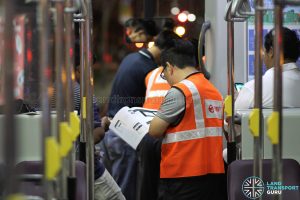
It is not known if there are service recovery measures in place when the ODPB (Night Bus) application breaks down.
While the ODPB (Night Bus) has never faced such large-scale technical issues, a similar failure has happened before. On 20 February 2019, a technical issue with the BusNow application disrupted the ODPB (Marina-Downtown) service during the AM Off Peak session (11.00am – 3.00pm). Commuters were informed through an app notification that the service was unavailable, while regular service (20 min frequency) was restored on Bus Services 400 & 402.
It is possible that NR7 will be re-activated if such a failure were to happen in the midst of ODPB (Night Bus) service.
8. Commuters unaware of ODPB Trial
The implementation of this trial has been rather unforgiving to regular commuters. For example, For the first few weeks of the ODPB trial, commuters along NR7’s route were unsuccessful in their attempts to flag down passing ODPB (Night Bus) buses, since a booking has not been made through the application (notably in the Geylang area). One possibility is that these commuters were unaware of the ODPB trial and that more leeway should be offered (e.g. stopping for flagging passengers) to allow for some form of ‘transition period’ for these commuters.
As of March 2019, commuters were still observed trying to flag the On-Demand (Night Bus) or waiting for non-existent buses along NR7’s route during the late-night hours.
9. Lost catchment areas at Tanah Merah
Finally, although the ODPB (Night Bus) was intended to replace NR7 for the purposes of this trial, it does not serve the Tanah Merah, Simei and Pasir Ris areas. In particular, Simei and Pasir Ris both have Nite Owl 4N from the City, but the ODPB (Night Bus) curiously omits Tanah Merah from its catchment area. As such, residents at Tanah Merah are left without night bus connections for the duration of this trial, save for a long walk to geofenced bus stops at Bedok North Rd and New Upp Changi Rd.
10. Road Closure / Bus Diversion scenario
The ODPB (Night Bus) application was tested during a route diversion scenario on Saturday, 9 March 2019. During the Chingay Night Fiesta 2019 @ Orchard Road, a section of Orchard Road was closed, and eastbound bus services were diverted to Grange Road, skipping Tang Plaza and Lucky Plaza. These bus stops were reflected as ‘unavailable for booking’ within the mobile app.
From Orchard Turn, the routing application was slow to respond, and advised an impossible U-turn manoeuvre at the junction with Orchard Blvd (First image). By the time the correct diversion route was processed (Second image), the bus had missed the left turn slip road and was forced to continue straight along Orchard Blvd.
Following which, the app advised another impractical u-turn at Grange Road (at the junction with Tanglin Road) (Third image). These point to several hiccups in the routing software when the bus deviates out from its normal operating area. The final diversion routing is illustrated below.
Concluding remarks
The On-Demand Public Bus (Night Bus) trial offers commuters with flexible inter-town and intra-town commuting options during the late-night hours. However, the software has some room for improvement, especially with regards to the routing algorithm. Ironing out minor hiccups with the software is just one part improving the commuting experience—it was also observed that many commuters were unaware of the suspension of NR7, with some unsuccessfully trying to flag or board the On-Demand bus without a booking. In addition, the reduced coverage area of the Night Bus trial disadvantaged residents of Tanah Merah, Simei and Pasir Ris who are no longer offered connections previously offered by NR7.
Pending the outcome of this trial, the LTA may expand the ODPB (Night Bus) to other parts of Singapore. These measures would also consolidate the current fixed-route night bus network, maximizing their catchment area and reduce duplicating routes in the long run.
We hope you have enjoyed reading our ODPB (Night Bus) review article.
Gallery:
External Links & References:
Back to On-Demand Public Bus (Night Bus – CBD to Bedok / Tampines)
Back to On-Demand Public Bus
Back to Bus Services
